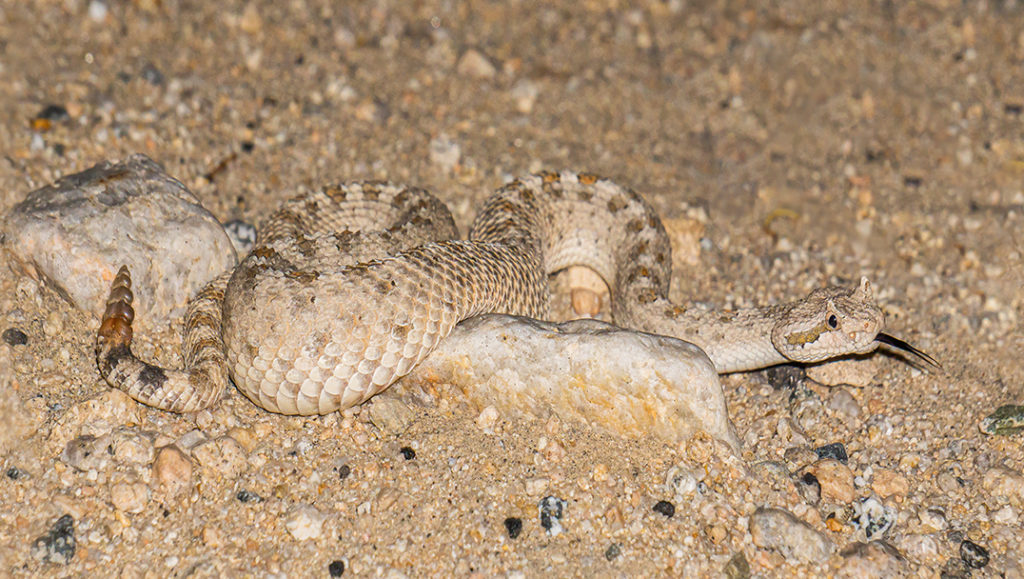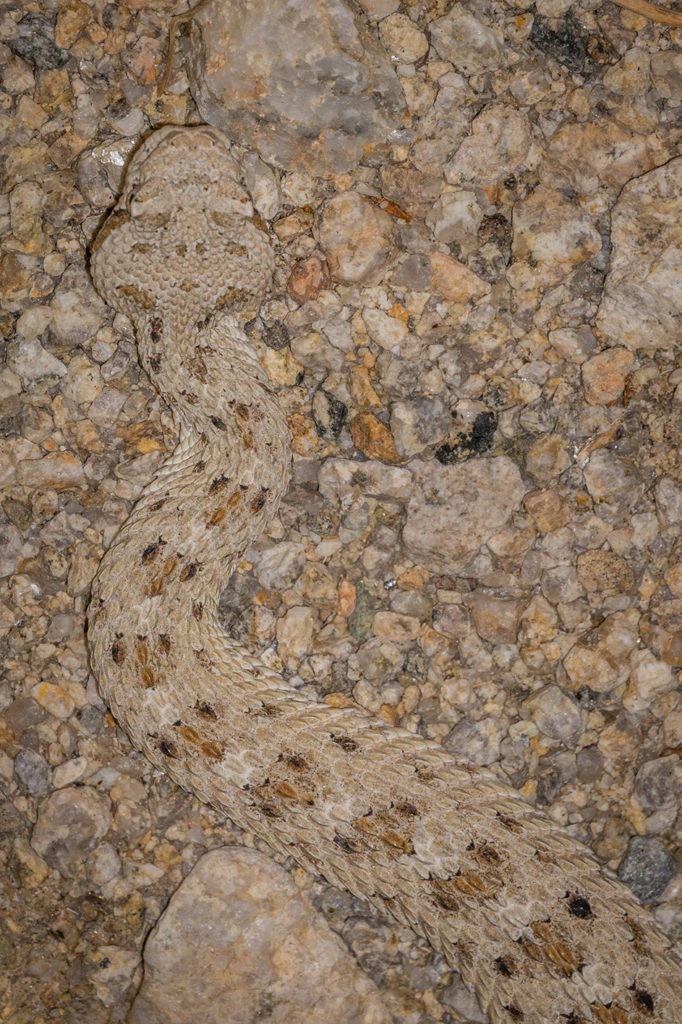The Sidewinder Rattlesnake (Crotalus cerastes) as well as the Desert Horned Viper (Cerastes cerastes) are small to medium sized vipers commonly found in sandy desert regions – the former in the Southwestern United States and Mexico, and the latter in North Africa and parts of the Middle East.
Sidewinders and Horned Vipers are incredibly convergent, except sidewinders possess heat-sensitive pit organs that enable them to sense their prey; Horned Vipers do not. Horned Vipers are also sans rattle, as rattlesnakes only inhabit North, Central, and South America.

In the Americas, three subspecies are recognized based on their location: Mojave, Sonoran, and Colorado desert sidewinders. As the name implies, these snakes are distinguishable by their supraorbital horns and unique method of locomotion, referred to as “sidewinding”, which leaves interesting j-shaped tracks in loose sand (as evidenced in this video). Sidewinders are capable of other, more traditional forms of snake movement as well.
While sidewinding, only two points of the snake’s body are in contact with the earth at any given time, allowing them to move quickly without overheating. Sidewinders can reach top speeds of 18 miles per hour (roughly 29 kilometers per hour).
Adult Sidewinders can reach a length of 19 to 31 inches (50-80 cm), although they are often no longer than 24 inches. The females are larger than the males, which is unusual for pit vipers. Each snake will typically have 21 rows of keeled dorsal scales throughout their midbody region. Females have up to 144 ventral scales while males have 141 or less. Their trademark “horns” which consist of raised scales above the eyes, are believed to be an adaptation that provides visual shade and helps prevent sand from getting in their eyes.
Sidewinders are light in color and their patterning closely resembles the desert sand and rocks in which they live. Depending on their exact location, they can be shades of tan, light brown, pink, orange, and grey, with darker blotches and occasional charcoal-colored spots on the back. These snakes are nocturnal during the hot summer months and diurnal when the weather is cooler. During the day, they can often be found hiding under rocks, in dens, or simply buried in the sand with a small portion of the head and back exposed.

As previously mentioned, Crotalus cerastes are pit vipers. At night, they use the heat sensitive pits on the front of their heads to hunt for rodents, birds, and lizards. Long, hollow, movable fangs connected to venom glands are used to envenomate, and quickly immobilize their prey. As an ambush hunter, Sidewinders strike their prey then release it and follow the scent trail until the animal dies and they can swallow it whole.
Although venomous, Sidewinder venom is less potent than most other rattlesnakes. In most cases, their venom is only strong enough to kill prey of up to 30 or 40 pounds (13 to 18 kilograms). In healthy adult humans, side effects include pain, bruising, and swelling that can occasionally cover entire limbs and the trunk. Like other venomous snakes, Sidewinders can control the amount of venom injected, what fang injects the venom, and fangs are replaced if broken.
Sidewinders are ovoviviparous, meaning the gravid female keeps and hatches 8-23 fertilized eggs inside her body, then gives birth to live babies. Neonate sidewinders exhibit extraordinary homeothermy behavior that has not been observed in any other snake species. To maintain an average aggregate temperature of 90 degrees Fahrenheit (32 degrees Celsius), neonate sidewinders spend the first year of their lives with their siblings, literally blocking the opening to their birthing den during the day. They intertwine to form a “multiple-individual mass” that, while gathered at the entrance of their burrow, allows them to absorb heat from the sun while at the same time, benefitting from the cool interior of their hole. This helps regulate the body temperature and keep it at the ideal point for shedding.
According to the IUCN Red List, Crotalus cerastes conservation status is listed as “Least Concern”, because they are widely distributed with a stable population. Sidewinders are one of the most common snakes throughout the Southwestern United States.